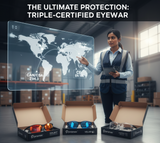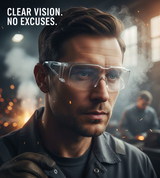More Than Goggles: The Specialized Eye Protection Needed for High-Heat Industrial Environments
In facilities that process metal at extreme temperatures, eye safety is a complex, multi-layered challenge. The environment presents hazards far beyond simple flying debris; workers are exposed to intense radiant energy, corrosive chemicals, and high-velocity particulates.
Standard clear safety glasses are a baseline, but they cannot provide adequate protection against the specific dangers found near furnaces, quench tanks, and abrasive cleaning equipment. To achieve true eye safety, your PPE program must address three distinct hazards.
1. The Infrared and UV Hazard (Furnace Viewing)
When workers look into the open ports of a furnace or view parts at thousands of degrees, they are exposed to intense infrared (IR) and ultraviolet (UV) radiation. Over time, IR exposure can cause thermal damage to the retina (such as cataracts and corneal burns), while UV exposure can cause painful "welders flash."
-
The Solution: Workers who regularly view high-temperature processes need specialized Cobalt Blue or specific IR/UV filtered lenses. These tinted lenses block the harmful radiation while allowing the worker to accurately gauge the temperature of the glowing metal—a critical task in quality control.
2. The Chemical Splash Hazard (Quench and Degreasing)
Processes involving quench tanks, degreasing stations, and specialized chemical treatments utilize hot oils, polymer solutions, and harsh caustics. Chemical splash is a constant, sudden threat. Standard safety glasses with side shields leave large areas around the eye exposed.
-
The Solution: Full-coverage protection is non-negotiable here. Workers must wear Splash Goggles (with indirect ventilation to prevent fogging) or a full-coverage Face Shield worn over safety glasses. These products form a complete seal around the eye area, blocking liquid from all directions.
3. The High-Velocity Impact Hazard (Blast Cleaning and Machining)
Operations involving abrasive cleaning, machining, milling, or grinding create a risk of high-velocity impact from metal chips, abrasive media, and flying debris.
-
The Solution: Every piece of eye protection—glasses, goggles, or face shields—must meet the stringent ANSI Z87.1 High-Impact Standard. This certification ensures the eyewear can withstand both high-mass and high-velocity impacts, ensuring the lens won't shatter into the eye upon collision.
Moving to a Specialized Strategy
A single pair of clear safety glasses is insufficient for an environment with such varied and severe risks. Safety managers must identify the specific task (High-Heat Viewing, Chemical Processing, or Abrasive Cleaning) and equip the worker with the appropriate, specialized eyewear.
Eye injury is one of the most common and costly workplace accidents. Don't settle for basic protection. Upgrade to a specialized eye safety program today.
Recent Posts
-
The Ultimate Protection: Why Triple-Certified Eyewear is Essential for Modern Safety Programs
Introduction For safety managers overseeing operations across North America and Europe, compliance …3rd Dec 2025 -
Stop Wasting Money on PPE: 3 Ways Safety Managers Can Optimize Eyewear Selection
Introduction Safety is never the place to cut corners, yet inefficient spending on Personal Protect …1st Dec 2025 -
Clear Vision, No Excuses: Why Anti-Fog Safety Glasses Are Non-Negotiable
In demanding work environments, crystal-clear vision isn't a luxury—it's a critical safety requirem …26th Nov 2025



